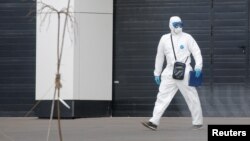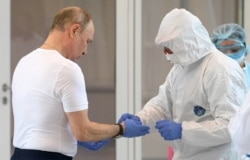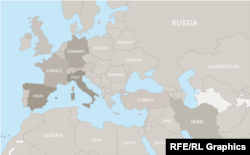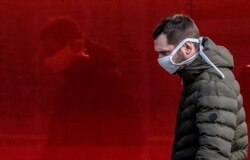A woman, a 69-year-old Muscovite, died on March 24 at a clinic in the Russian capital specializing in treatment of the coronavirus. Authorities said she died of cancer that she had been battling, not the disease that has been ravaging the world.
A week earlier, a 79-year-old woman who was in fact diagnosed with COVID-19 died at a Moscow infectious disease hospital. Authorities attributed her death to an embolism – a blood clot – rather than the coronavirus.
And as of March 24, Russia’s official tally of confirmed coronavirus cases stood at just 495, clustered mainly in Moscow but also scattered across at least 46 cities and regions. That put Russia, with a population of about 144 million, at a per-capita level comparable to places in Central America and southern Africa, where the coronavirus is so far almost nonexistent.
By contrast, many neighboring and nearby European nations are seeing much higher rates of confirmed cases. And then, of course, there’s China, where the virus originated and with which Russia shares a 4,200-kilometer border -- a border that Moscow ordered closed weeks ago, on January 30.
“The situation is on the whole under control,” President Vladimir Putin said on March 18. “Russia looks much better compared with other countries.”
So what exactly is going on with Russia’s coronavirus numbers?
Is the country in fact seeing abnormally low rates of infection, despite traveling tourists and cross-border trade? Or, as a growing number of Russians theorize, is the government keeping its official tally artificially low, perhaps to prevent panic or shield the shortcomings of the country's creaky health-care system?
Or maybe it’s a simpler bureaucratic answer: Is it just because of how the country has been testing for the cases up until now?
Here’s a look at what we know so far about Russia’s experience with the coronavirus.
Act Early, Act Decisively?
Russian authorities appear to have been aware of the dangers earlier than many countries.
With cases exploding in the Chinese province where the city of Wuhan is located, Russia moved to close down its massive land-and-river border with China, first to people, then to cargo.
The day after the World Health Organization declared a global health emergency on January 30, Deputy Prime Minister Tatyana Golikova announced the country’s first two cases, in two regions distant from Moscow. Six days later, the first of several government-charter flights arrived in a Siberian region, carrying 144 Russian citizens evacuated from Wuhan. They were quarantined for 14 days.
Since then, Russia’s tally of confirmed cases has climbed, albeit at a rate noticeably slower than other countries.
In Italy, the country outside of China that has been worst hit, cases were first publicly confirmed on January 31, and then jumped exponentially beginning on February 20, according to data compiled by Johns Hopkins University in the United States. There are more than 69,000 confirmed cases in Italy as of March 24.
In Spain, the other European country worst hit by the coronavirus, confirmed cases began jumping on March 6, and as of March 24 stood at just over 35,200.
Both countries are popular with Russian tourists, including an infectious disease specialist in the southern Russian region of Stavropol, who is now under criminal investigation for not self-isolating after returning home, and apparently infecting other doctors after continuing to give lectures and hold meetings.
That would suggest that Russians returning home from countries where the coronavirus was exploding could also be carrying the virus, and thus infecting anyone they come into contact with at similar rates.
And Russian authorities have so far not introduced severe measures like mandatory face masks or citywide lockdowns like other places have.
Testing Testing
In Russia, the bulk of the confirmed cases are located in the country’s most populous city: Moscow. Official figures, as of March 24, say 262 cases were in the Russian capital, plus an additional 35 in the region surrounding the city.
Russian authorities also report what seems to be an aggressive testing regime: nearly 166,000 nationwide. That’s comparable to testing numbers in other countries, though it dwarfs that of the United States, whose response to the coronavirus has been hampered by a lack of tests.
Still, the low rate of confirmed cases is tiny, and a statistical outlier compared with other exposed countries, experts say.
Interactive Coronavirus Map
One explanation for the apparent disparity is how testing has been conducted to date. Up until recently, suspected cases were tested using a tool developed by a state-funded laboratory in the Siberian city of Novosibirsk, known by its shorthand name Vektor.
But a Russian science blog called PCR News, which said it had reviewed the specific protocols of the lab’s test, said it only detects the virus if it is over a certain threshold in a sample, and that threshold is far higher. And it also appeared to give a higher than expected number of “false positives.”
“This may be the answer to the question why in Russia there are so few cases of coronavirus infection. It is possible that the ‘Vektor’ test reveals only the top of the pyramid,” the site said. “As a result, official statistics may incorrectly reflect the epidemiological situation, and the measures taken may not correspond to the real threat.”
On March 23, Moscow’s coronavirus task force said the testing protocol would be changed and samples would no longer be sent to the Novosibirsk laboratory for a second round of testing.
Classification Semantics
In recent months, Russian authorities have reported an uptick in cases involving another respiratory illness: pneumonia. The coronavirus can cause pneumonia, but so can other more run-of-the-mill exposures.
Russia’s statistics agency reported last week that pneumonia cases nationwide had increased by 3 percent compared with the 2018-19 season. In Moscow, they jumped by nearly 37 percent, according to the agency, known as Rosstat.
That’s fueled skeptics’ doubts that health officials were undercounting, or misclassifying, likely coronavirus cases as merely pneumonia.
The Doctors’ Alliance, an independent trade union of medical workers, has openly accused the government of lying to the public about the figures.
The skepticism has been further deepened by the two fatalities that involved people exposed to the coronavirus yet whose deaths have been classified otherwise.
On March 19, Moscow’s task force coordinating the coronavirus response announced that a 79-year-old woman who had tested positive for COVID-19 died at a Moscow infectious disease hospital. The woman, who had been hospitalized a week earlier, had diabetes and other health problems and was later transferred to an infectious disease unit, where she later died.
Doctors attributed her death to the coronavirus, but authorities later attributed it to a blood clot. They also did not say how she contracted the virus in the first place.
(The Coronavirus Resource Center at Johns Hopkins University, which monitors the spread of the virus, has continued to list one death in Russia since March 19, while the official Russian figure was zero as of March 24.)
On March 24, a 69-year-old woman died in a separate Moscow infectious disease unit. The tabloid newspaper Moskovsky Komsomolets reported she had been hospitalized after her daughter returned from Portugal. The woman reportedly tested positive for the coronavirus initially, but city officials later said she died from cancer and that her coronavirus results were in fact negative.
That semantic protocol – if someone who has the coronavirus dies of some other health issue while hospitalized for the coronavirus – may also help explain Russia’s low numbers.
In the Czech Republic, by contrast, the country’s health minister on March 24 announced a second coronavirus-related death: a man in his mid-40s. The man died of “widespread organ failure” and also had advanced-stage cancer.
“The coronavirus worsened his condition,” Health Minister Adam Vojtech wrote on Twitter.
Emergency Response
Numbers aside, the Kremlin seems to be taking the threat seriously.
In addition to shutting the border with China, authorities have taken a growing number of drastic measures. Foreigners have been temporarily barred from entry into the country.
Prime Minister Mikhail Mishustin on March 23 ordered officials to develop a system to track people who have come into contact with anyone with the coronavirus, using geolocation data from cell phones.
Days earlier, Moscow’s top police officials said the city’s surveillance cameras, using facial-recognition technology, had pinpointed more than 200 people who had broken quarantine.
“I believe that overall, we have the situation with coronavirus under control,” said Mishustin, who earlier announced a $4 billion fund to help limit the economic damage from the coronavirus.
Moscow’s mayor, Sergei Sobyanin, meanwhile, told residents over 65 and those with chronic illnesses to remain at home, and even offered small cash payments to encourage that. He also suggested the elderly leave Moscow proper, and, if they have countryside homes known as dachas, to go out to them.
At a meeting with Putin on March 24, Sobyanin signaled that Russia’s overall confirmed cases indeed might be artificially low.
“А serious situation…is unfolding,” Sobyanin said. “The number of people who are sick [with the coronavirus] is significantly higher in reality.”
"Some regions seem not to understand…. The issue is that the level of testing is very low. We don’t have a real picture," Sobyanin said.
Coronavirus And The Constitution
For any country, Russia included, the coronavirus presents major political, social, and economic challenges.
For the Kremlin, there’s an added reason why it’s a challenge beyond what other countries are facing.
On April 22, Russians are scheduled to vote on a package of amendments to the constitution, the most substantive changes to the document since its adoption 27 years ago. Weeks after the plan to amend the constitution was announced in January, Putin signaled support for another change – one that would allow him to seek reelection in 2024 and potentially remain president until 2036.
It’s unclear if he will, but for most Kremlinologists trying to discern Putin’s intentions, the most important thing is that the April 22 vote be accepted and seen as legitimate by Russians.
The Central Election Commission has already begun advertising for the vote, with imagery evoking World War II that avoids mention of prolonging Putin’s tenure in the Kremlin.
But apathy has grown among Russians, particularly as the country’s economy stagnates and voters tire of Putin. If Russians are too fearful of the coronavirus to go to the polls on April 22, that will further undermine how the vote is perceived.
Though some Kremlin allies in parliament have dismissed the possibility of the vote being postponed, the newspaper Vedomosti has reported that it is actively being considered at top government levels.
Another newspaper, Kommersant, reported on March 23 that the Central Election Commission had advised regional officials to halt the printing of ballots.
According to at least one Russian scientist, the country could be facing an explosion in cases in the coming weeks, not unlike what has happened in Italy.
“I have the impression for the moment that we’re about three weeks behind Italy, approximately,” Aleksandr Chepurnov, a Novosibirsk-based virologist and Academy of Sciences medical professor, told Russian state TV on March 23. “And, in principle, you should understand that most likely, we will experience the same history.”



















